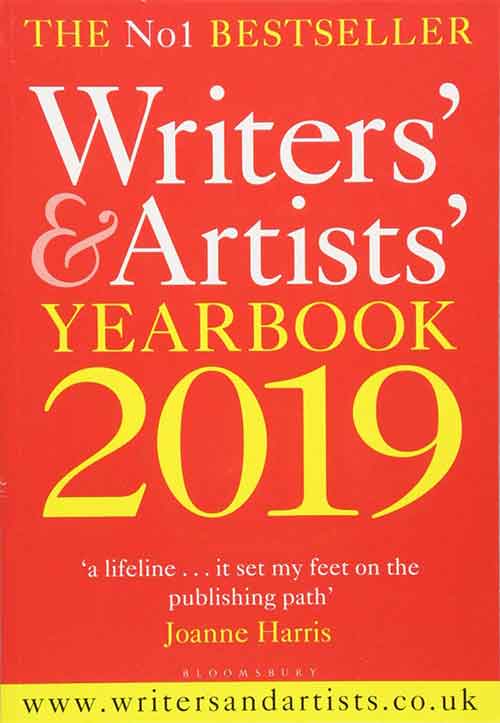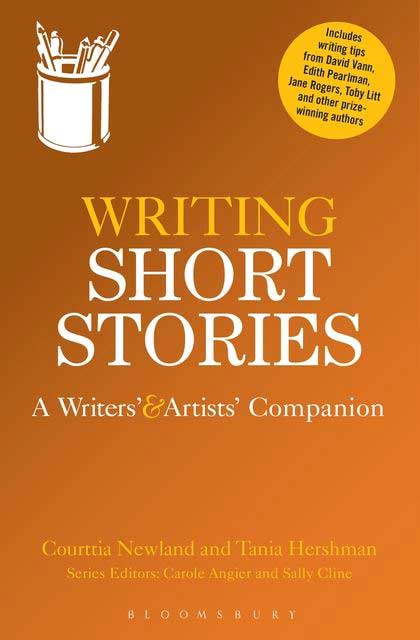On this page you’ll find a list of the following:
General Creative Writing Books
Writers’ & Artists’ Yearbook 2019 (Writers’ and Artists’)
This bestselling guide to all areas of publishing and the media is completely revised and updated every year. The Yearbook is packed with advice, inspiration and practical guidance on who to contact and how to get published.
The Cambridge Introduction to Creative Writing, David Morley
This book introduces students to the practice and art of creative writing and creative reading. It offers a fresh, distinctive synthesis of the discipline. Morley discusses the origins of creative writing, the various forms it has taken, and why we teach and learn the arts of fiction, poetry and creative nonfiction. He looks at creative writing in performance; as public art, as visual art, as e-literature and as an act of community. It’s not only a useful textbook for students and teachers of writing, but also an inspiring read in its own right.
The Handbook of Creative Writing, Steven Earnshaw, ed.
This is the inspirational resource for tutors, students and other creative writing professionals. 54 chapters cover the three central pillars of writing creatively: theories of creativity, the craft of writing and creative writing as a business. With contributions from over 50 experts, this is the essential guide to writing, and getting published, in the English-speaking world. New for this edition: chapters: on ‘indie publishing’, ‘social media’, ‘flash fiction’, ‘song lyrics and poetry’, ‘creative critical hybrids’, ‘collaboration in the theatre’, Inclusion of additional genres and activities; chapters updated to reflect changes in teaching, copyright & earning a living as a writer.
Short Story Guides
Short Circuit: A Guide to the Art of the Short Story. Edited by Vanessa Gebbie (Revised)
‘Short Circuit’ is a unique and indispensable guide to writing the short story. A collection of 24 specially commissioned essays from experienced writers and successful teachers of the short form, this new edition has been updated and is an intensely practical, generous book. Each expert discusses their own writing processes, sharing tried and tested writing exercises and lists published work they find inspirational.
Writing in General and the Short Story in Particular, Rust Hills
Writing in General and the Short Story in Particular is a master class in writing—especially short story writing. Drawing on a lifetime of experience and success, this practical guide explains essential techniques of writing fiction—from developing character to crafting plots to effectively employing literary techniques. Clear and concise enough for any beginner but wise and powerful enough for any pro, Writing in General is a classic to be savoured by both aspiring and seasoned writers.
Writing Short Stories, Ailsa Cox
Ailsa Cox, a published short-story writer, guides the reader through the key aspects of the craft, provides a variety of case studies and examples of how others have approached the genre and sets a series of engaging exercises to help hone your skills. This inspiring book is the ideal guide for those new to the genre or for anyone wanting to improve their technique.
Writing Short Stories (Writers’ and Artists’ Companions), Courttia Newland and Tania Hershman
Writing Short Stories: A Writers’ and Artists’ Companion is an essential guide to writing short fiction successfully. PART 1 explores the nature and history of the form, personal reflections by the editors, and help getting started with ideas, planning and research. PART 2 includes tips by leading short story writers, including: Alison Moore, Jane Rogers, Edith Pearlman, David Vann, Anthony Doerr, Vanessa Gebbie, Alexander MacLeod, Adam Thorpe and Elspeth Sandys. PART 3 contains practical advice – from shaping plots and exploring your characters to beating writers’ block, rewriting and publishing your stories.
Write Short Stories and Get Them Published: Teach Yourself, Zoe Fairbairns
Written by one of the country’s leading experts on the short story, this book is ideal if you want to write creatively in a genre that is increasingly attracting attention from publishers, and which offers plenty of competition and festival opportunities for you to showcase your work. The new edition includes updated material on web resources and outlets and provides new information on self-publishing. In addition, it discusses genres such as micro-fiction, and throughout is fully updated with new resources, events, slams and competitions.
How to Write a Short Story, Get Published & Make Money, Christopher Fielden
In How to Write a Short Story, Get Published & Make Money, Chris Fielden uses 16 of his published short stories as case-studies, enabling the reader to clearly see how his advice and tips were used in practice to achieve publishing success. Presented in a humorous and conversational style, the book teaches you: how to write well-constructed, publishable short stories, the value of conducting market research and how it can give your stories a much better chance of being published, things to consider when submitting your short stories to competitions and magazines, how to learn from reading, how to learn from rejection and criticism, how to make money from your writing, including realistic expectations regarding how much you can earn.
Flash Fiction
The Rose Metal Press Field Guide to Writing Flash Fiction: Tips from Editors, Teachers, and Writers in the Field
With its unprecedented gathering of 25 brief essays by experts in the field, The Rose Metal Press Field Guide to Writing Flash Fiction meets the growing need for a concise yet creative exploration of flash fiction. The book’s introduction provides a comprehensive history of the short short story. This guide is a must for anyone in the field of short fiction who teaches, writes, and is interested in its genesis and practice. Featuring essays by: Steve Almond, Rusty Barnes, Randall Brown, Mark Budman, Stace Budzko, Robert Olen Butler, Ron Carlson, Pamelyn Casto, Kim Chinquee, Stuart Dybek, Pia Z. Ehrhardt, Sherrie Flick, & Vanessa Gebbie.
The World in a Flash: How to Write Flash-Fiction: Volume 1, by Calum Kerr
An introductory book for new and experienced writers alike, on the wonders of flash-fiction, what it is, what makes it work, and how to write them. Topics include: Using Prompts Crafting Characters Unpicking Plots Using Dialogue Perspective and Structure Experimentation Reflection Editing and RewritingDr Calum Kerr, academic, flash-fiction writer and Director of National Flash-Fiction Day UK, shares the knowledge and experience he has gained from years of writing, reading, teaching and publishing flash-fictions.
Writing Flash Fiction: How to Write Very Short Stories and Get Them Published, Carly Berg
Writing flash fiction is a fun, easy way to break into print and quickly establish yourself as a professional author. This book shows you everything you need to write great stories under 1,000 words, as well as how and where to get them published. It concludes with tips for re-publishing those stories all together as a book.
Flash Fiction International – Very Short Stories from Around the World
What is a flash fiction called in other countries? In Latin America it is a micro, in Denmark kortprosa, in Bulgaria mikro razkaz. These short shorts, usually no more than 750 words, range from linear narratives to the more unusual: stories based on mathematical forms, a paragraph-length novel, a scientific report on volcanic fireflies that proliferate in nightclubs. Flash has always and everywhere been a form of experiment, of possibility. A new entry in the lauded Flash and Sudden Fiction anthologies, this collection includes 86 of the most beautiful, provocative, and moving narratives by authors from six continents, including best-selling writer Etgar Keret, Zimbabwean writer Petina Gappah, Korean screenwriter Kim Young-ha, Nobel Prize winner Czeslaw Milosz, and Argentinian Queen of the Microstory Ana Maria Shua, among many others.
Academic Texts
Introduction to Literature, Criticism and Theory, Andrew Bennett and Nicholas Royle
An essential guide to literary studies. Starting at ‘The Beginning’ and concluding with ‘The End’, chapters range from the familiar, such as ‘Character’, ‘Narrative’ and ‘The Author’, to the more unusual, such as ‘Secrets’, ‘Pleasure’ and ‘Ghosts’. Now in its fifth edition, Bennett and Royle’s classic textbook successfully illuminates complex ideas by engaging directly with literary works, so that a reading of Jane Eyre opens up ways of thinking about racial difference, for example, while Chaucer, Raymond Chandler and Monty.
The Modernist Short Story: A Study in Theory and Practice, Dominic Head
The modernist period saw a revolution in fictional practice, most famously in the work of novelists such as Joyce and Woolf. Dominic Head shows that the short story, with its particular stress on literary artifice, was a central site for modernist innovation. Working against a conventional approach and towards a more rigourous and sophisticated theory of the genre, using a framework drawn from Althusser and Bakhtin, he examines the short story’s range of formal effects, such as the disunifying function of ellipsis and ambiguity. Separate chapters on Joyce, Woolf and Katherine Mansfield highlight their strategies of formal dissonance, involving a conflict of voices within the narrative. Finally, Dominic Head’s challenging conclusion takes the implications of his study into the age of postmodernism.
The New Short Story Theories, Charles E. May
An important part of this revival of interest, Short Story Theories continues to attract a strong and loyal audience among students and teachers. The New Short Story Theories includes a few basic pieces from the earlier volume―Poe’s Hawthorne review, Brander Matthew’s extension and formalization of Poe’s theories, and essays by Randall Jarrell, Elizabeth Bowen, and Nadine Gordimer―but most of the essays are new to the collection and address problems of definition, historical considerations, issues of technique, and cognitive approaches.


